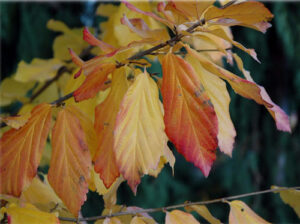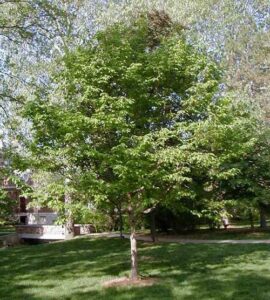Leaflet: Native & Climate-Adapted Trees
Considering Natives and Climate Adapted Non-natives
The right tree, right place ethos is complicated by urban environments and climate change
We invite you to consider the cascara (Frangula purshiana), a tree native to the Pacific Northwest. It has pretty autumn colors, does well in both shade and sun, and is a great backyard habitat tree, with small berries that attract native and migrating birds. This low-maintenance tree is a wonderful native option for your street or yard, and we still have plenty available in our tree store this season!
We’re big fans of native trees at Friends of Trees. It’s important to steward native plants as food and shelter for native animals, and in so many instances, natives are the right choice when you’re looking to put the right tree in the right place.
“There’s always a place for native trees in our hearts and in our gardens,” says Neighborhood Trees Senior Specialist Andrew Land. “But there’s also a place for non-native, locally hardy trees in the urban environment.”
The urban environment presents unique challenges to trees that would otherwise do well in a forest. Concrete and asphalt trap both heat and cold. The soil is often stripped of top soil and compacted. And trees are usually stranding alone, rather than part of a multilayered forest ecosystem.
Urban spaces are also usually a degree or two warmer than natural areas, which is only made worse by climate change. Some local species, like the western red cedar, are already struggling due to warmer temperatures.
“The climate is changing, and we can anticipate it continuing to change dramatically,” Andrew says. “So it makes sense to consider trees that would do well here, especially if they’re drought-tolerant free of pests and disease. We’re told to consider planting trees that thrive 500 miles south of here, because those should thrive here in 20 years based on climate change models.”

One such non-native is the ‘Persian spire’ Persian ironwood (Parrotia persica ‘JL Columnar’), a columnar cultivar of a tree native to Iran. It’s drought-tolerant, has no problems with pests or diseases, and is expected to do well as a street or yard tree in the face of climate change. It’s a great alternative to cascara that you should have no qualms about selecting.

Another is the swamp white oak (Quercus bicolor, shout out to our Year of the Oak!), which is native to eastern North America and one of our favorite oaks. It turns out that trees well-suited to swamps also do really well in urban environments. Their roots are accustomed to anaerobic conditions. Whether they’re underwater or under concrete, they can handle a lack of oxygen. 400 swamp white oaks were planted at the 9/11 Memorial in New York City.

The American hophornbeam is another great backyard tree. It’s native to eastern North America, and has flowers that look like hops, a characteristic that makes them feel right at home here.
“When it comes to considering trees for our urban forest, variety is really the spice of life,” Andrew says. “If a disease or pest takes out a particular species, you don’t want that to be the only tree you have. Diversity creates resilience.”

